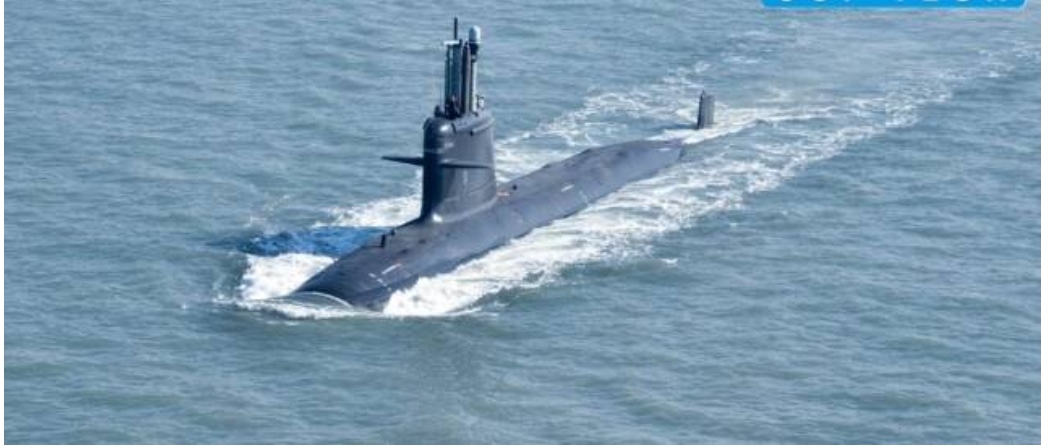New submarines for the Navy : Scorpene class
The three additional Scorpene submarines will be procured under Buy (Indian) category and will be built by the Mazagon Dock Shipbuilders Limited (MDL).

The 5th submarine of Project–75 Vagir, inducted into service this year in January. (Wikimedia Commons)
The Defence Acquisition Council, the apex decision-making body for the acquisition of military equipment for India’s armed forces, on Thursday (July 13) cleared proposals worth thousands of crores to buy three additional Scorpene submarintes and 26 Rafale Marine fighter jets for the Navy.
The decision coincides with Prime Minister Narendra Modi’s two-day Paris trip, which began the on same day. The DAC decision has paved the way for an announcement on procuring the submarines during PM Modi’s trip to France.
The three additional Scorpene submarines will be procured under Buy (Indian) category and will be built by the Mazagon Dock Shipbuilders Limited (MDL) in Mumbai.
The new submarines
The MDL is building six Scorpene class submarines under the Project-75, as part of a $ 3.75 billion deal signed in October 2005, which allowed for transfer of technology from the French defence firm, Naval Group. Of these, five have already been commissioned and the last one will likely be commissioned early next year. This project saw significant delays, with the first submarine originally slated for delivery in 2012.
The fifth submarine under this project, INS Vagir, was commissioned in January this year. The others — INS Kalvari, INS Khanderi, INS Karanj and INS Vela were commissioned between 2017 and 2021. In May this year, the sixth submarine Vagsheer began her sea trials.
Now, the DAC has given clearance for three additional Scorpene submarines to be built by the MDL. These are likely to have the same specifications as the ones before.
The need for the three additional submarines
Officials privy to the development said the need to procure the three additional submarines was felt in the backdrop of the delayed deliveries of submarines under Project 75, as well as to bolster India’s dwindling submarine fleet.
Currently, the Navy has 16 conventional submarines in service – seven of the Sindhughosh class (Russian Kilo class), four of the Shishumar class (modified German Type 209) and five of the Kalvari class (French Scorpene class). However, to carry out its full spectrum of operations the Navy needs at least 18 such submarines.
Moreover, at any given time, around 30 per cent of the submarines are under refit, thus further bringing down the strength of operational submarines. Even the latest Kalvari-class submarines are scheduled to go for upcoming refits very soon.
As per the Defence Ministry, the procurement of additional submarines, with higher indigenous content, will not only help in maintaining required force level and operational readiness of the Navy, but also create significant employment opportunities in the domestic sector.
It will also help the MDL in further enhancing its capability and expertise in submarine construction, it said in a statement issued on Thursday.
What are the capabilities of the Scorpene submarines?
The Scorpene submarines are conventional attack subs, meaning that they are designed to target and sink adversary naval vessels. Capable of launching a large array of torpedoes and missiles, they are also equipped with a range of surveillance and intelligence-gathering mechanisms.
They are around 220 feet long and have a height of approximately 40 feet. They can reach the top speeds of 11 knots (20 km/h) when surfaced and 20 knots (37 km/h) when submerged.
Scorpene class submarines use diesel electric propulsion systems, with an endurance – ability to operate independently without refuelling – of approximately 50 days. This sort of propulsion system alternates between using diesel (for functioning on the surface) and electric (for functioning underwater).
However, these electric batteries need to be recharged by the diesel engine after prolonged submersion, meaning that the submarine has to periodically surface to continue operating.
How do they compare with nuclear submarines?
Nuclear submarines are coveted due to their theoretically unlimited endurance – a nuclear reactor on a submarine has an operational life of up to 30 years. As they are not propelled by batteries, these submarines only need to come to the surface for replenishing supplies for the crew. They are also able to move much faster than conventional submarines.
However, this is not to say that a navy should only choose to procure nuclear submarines. First and foremost, nuclear submarines are expensive and require a significant amount of specialised experience to operate. Second, with advancements in diesel electric technology, the range of conventional submarines as well as their stealth has gone up significantly.
As per a paper by the US Naval institute, “When operating on batteries, AIP-equipped submarines are almost silent, with the only noise coming from the shaft bearings, propeller, and flow around the hull.” The Indian navy will retrofit all of its Scorpene class submarines with air independent propulsion or AIP systems, beginning in 2024. This will boost their endurance as well as stealth.
Currently, India has 2 nuclear-powered submarines (SSBMs) of the Arihant class in service.



